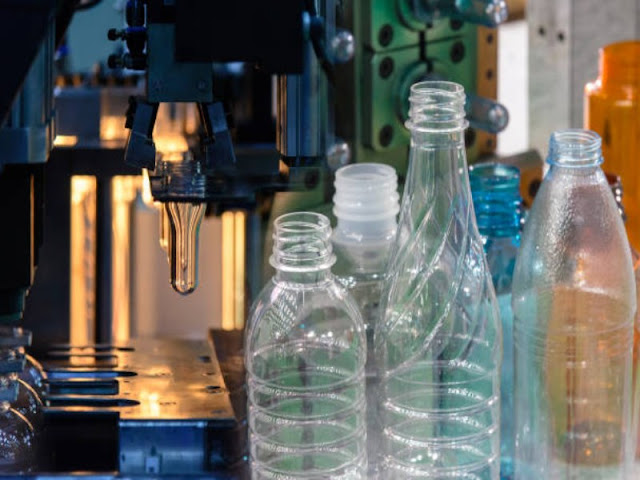plastic bottle manufacturing

Plastic bottle manufacturing has faced growing scrutiny in recent years due to concerns about environmental sustainability and plastic waste. The industry has responded by adopting a range of sustainable practices to reduce its environmental impact, conserve resources, and promote recycling. This article explores some of the key sustainable practices in plastic bottle manufacturing.
- Recycled
PET (rPET) Usage
The incorporation of recycled PET (rPET) into plastic bottle
manufacturing is one of the most significant sustainable practices in the
industry. Instead of relying solely on virgin plastic resin, manufacturers are
using rPET, which is produced from post-consumer or post-industrial PET bottles.
This reduces the demand for new plastic production and diverts plastic waste
from landfills and oceans.
rPET usage offers several environmental benefits:
- Reduces
the consumption of non-renewable resources.
- Lowers
energy consumption during the production process.
- Decreases
the carbon footprint associated with manufacturing.
Many beverage companies and plastic bottle manufacturers
have committed to using rPET in their products, contributing to a more
sustainable approach to plastic bottle production.
- Lightweighting
Lightweighting is a practice that involves designing and
producing plastic bottles with thinner walls while maintaining structural
integrity. By using less plastic material per bottle, manufacturers reduce the
overall environmental impact. Lightweighting offers several advantages:
- Decreases
the amount of plastic required for production, reducing resource
consumption.
- Lowers
transportation costs due to reduced weight, which also reduces carbon
emissions.
- Enhances
sustainability efforts without compromising the quality or performance of
the bottles.
Lightweight bottles are especially popular in the beverage
industry, where millions of bottles are produced daily. The reduction in
material usage per bottle results in significant resource and energy savings
over time.
- Energy
Efficiency
Energy efficiency measures have become an integral part of
sustainable plastic bottle manufacturing. These practices aim to reduce the
energy consumption of the manufacturing process, which has both economic and
environmental benefits. Common energy-saving strategies include:
- Optimizing
manufacturing equipment to reduce energy waste.
- Implementing
energy-efficient lighting and HVAC systems in the production facilities.
- Using
renewable energy sources such as solar and wind power.
- Incorporating
automation and control systems to minimize energy consumption.
Reducing energy usage not only lowers operational costs but
also decreases the carbon footprint of plastic bottle manufacturing.
- Waste
Reduction and Recycling
Sustainable plastic bottle manufacturing focuses on
minimizing waste throughout the production process. Manufacturers implement
practices such as:
- Recycling
and reusing waste materials generated during production.
- Implementing
closed-loop systems to recover and reuse process water.
- Reducing
scrap and material loss by optimizing manufacturing processes.
Furthermore, plastic bottle manufacturers are actively
promoting recycling at the consumer level by including recycling symbols and
information on their products. Collaborating with recycling facilities and
organizations to improve the collection and processing of plastic bottles is
also part of these efforts.
- Closed-Loop
Systems
Closed-loop systems are designed to capture, recycle, and
reuse materials within the manufacturing process, minimizing waste and resource
consumption. In plastic bottle manufacturing, closed-loop systems can include:
- Reusing
process water to minimize water waste and reduce the environmental impact.
- Recycling
scrap and off-spec bottles to produce new bottles, thus reducing the need
for virgin resin.
- Reclaiming
heat energy from the production process to lower overall energy
consumption.
Closed-loop systems are essential components of a circular
economy, which promotes the continual use of materials and resources without
excessive waste or depletion.
- Green
Manufacturing Practices
Green manufacturing practices involve adopting eco-friendly
technologies and processes in plastic bottle manufacturing. This includes:
- Using
environmentally friendly additives and stabilizers in plastic
formulations.
- Incorporating
non-toxic dyes and pigments.
- Implementing
cleaner production methods to reduce emissions and hazardous waste.
- Reducing
the use of harmful chemicals in the manufacturing process.
These practices ensure that plastic bottle production is as
environmentally friendly as possible, mitigating the negative impacts on the
ecosystem and human health.
- Sustainable
Packaging
In addition to improving the manufacturing process,
sustainability initiatives in the plastic bottle industry also extend to the
design and functionality of the bottles themselves. Sustainable packaging
innovations include:
- The
development of biodegradable plastics for bottle production, which break
down naturally and reduce long-term environmental impact.
- The
use of barrier technologies that protect the bottle's contents, extending
the shelf life of products and reducing waste.
- Customizing
bottle designs to minimize material usage while still serving their
intended purpose.
Promoting the use of sustainable packaging options is
essential in reducing the environmental impact of plastic bottles.
- Circular
Economy Initiatives
The transition to a circular economy is a driving force
behind sustainable practices in plastic bottle manufacturing. The circular
economy aims to reduce, reuse, and recycle materials and products, promoting a
closed-loop system. Plastic bottle manufacturers are actively participating in
circular economy initiatives by:
- Implementing
take-back programs to collect and recycle used bottles.
- Collaborating
with recycling organizations to improve the recycling infrastructure.
- Encouraging
consumers to recycle through clear labeling and public awareness
campaigns.
These initiatives help keep plastic bottles within the
production cycle and minimize their environmental impact.
- Sustainable
Sourcing
Sustainable plastic bottle manufacturing also encompasses
responsible sourcing practices. Manufacturers are increasingly seeking to
procure materials from suppliers committed to ethical and sustainable sourcing
of raw materials. This includes using recycled materials, reducing the environmental
impact of raw material extraction, and supporting fair labor practices.
By sourcing materials responsibly, manufacturers contribute
to the overall sustainability of the plastic bottle industry and help drive
positive change throughout the supply chain.
- Product
Innovation
Sustainable plastic bottle manufacturing includes product
innovation aimed at creating eco-friendly alternatives to traditional plastic
bottles. Examples of such innovations include:
- Plant-based
plastics, which use renewable resources like sugarcane or cornstarch to
create biodegradable bottles.
- Multi-layer
bottles with improved barrier properties to reduce the need for additional
packaging materials.
- Bottles
designed for easy disassembly and recycling.
These innovations drive sustainability in the industry by offering eco-friendly alternatives and reducing the environmental impact of plastic bottle production.


